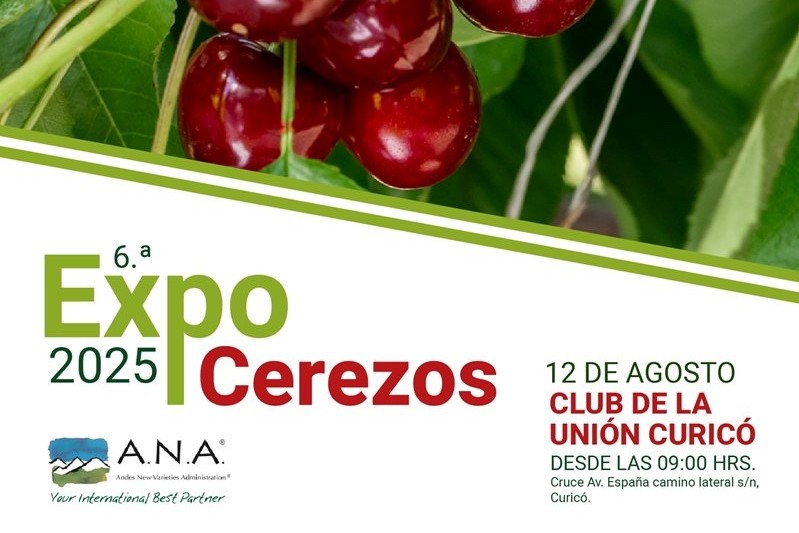On the occasion of the sixth edition of ExpoCerezos held in Curicó, ANA Chile® presented a comprehensive report on the 2024/25 season, marked by a significant increase in production and the consolidation of new early varieties such as Sweet Aryana®, Nimba and Pacific Red.
Chile closed the season with 626,000 tons exported, 51% more than the previous cycle, with most shipments destined for China and a notable advance in the early-fruit window.

Commercial analysis of the 2024/2025 season
Andrés Valdivieso, Commercial Director of ANA Chile®, highlighted, through concrete examples from exporters, that the Nimba cv., Frisco cv., Pacific Red cv., Sweet Aryana® and Sweet Lorenz® varieties consistently matured before Santina in most exported volumes, while maintaining good sizes (mostly 2J or larger) and attractive prices.
In the case of Areko cv., its positioning as a high-quality fruit, with a size above 30 mm and excellent firmness, places it as a strategic option for diversifying the mid-season export window. Download the presentation here (in Spanish).
Agroclimatological data and productivity
Next, Walter Masman, a renowned industry consultant, offered an extensive overview of agroclimatological data from recent years and from the current season. He also presented data on the behavior of varieties in relation to their sensitivity to chill-hour accumulation and accumulated spring temperatures, along with a study on pollen germination across varieties, correlating it with final productivity.
Management of cv. Areko
For his part, specialist Luis Valenzuela provided an in-depth look at the productive management of cv. Areko, emphasizing that its productive success depends on precise pollination management and vigor control.
The cv. Areko is self-fertile (S1S3) and requires compatible pollinizers such as Kordia, Skeena or Santina, whose optimal distribution varies according to the agroclimatic zone.
In warm areas, for example, no more than two consecutive rows of cv. Areko are recommended, along with a combination of Santina and Skeena to maximize bee visits and efficient fruit set.
Valenzuela’s research also highlighted the use of technologies such as supplemental pollination with compatible pollen, the application of regulators (AVG and auxins) to improve fruit set and retention, as well as water and nutritional management to avoid heat stress or calcium deficiency. These are key factors in maintaining firmness, shine and a green stem upon arrival. Download the presentation here (in Spanish).
Outlook and emerging markets
In his presentation, Luis Sandoval, manager at the exporting company Chilfresh, addressed the opportunities and challenges that will shape the sector in the coming years.
Among the opportunities, he highlighted the need to expand presence in the weeks prior to week 47 and after week 2, as well as the development of emerging markets such as India, Europe and Southeast Asia.
Regarding challenges, he warned of increasing pressure from quarantine pests such as fruit fly and Lobesia botrana, as well as internal logistical limitations that could compromise the regular flow of exports.
Cherry Expo 2025 and new varieties
Marcelo Arriagada, technical director for cherries at ANA Chile®, provided an in-depth analysis of the season, highlighting how the increase in early production and varietal diversification made it possible to respond more effectively to rising volumes.
He also stressed the importance of adapting orchard production to the specific needs of each variety, optimizing size, firmness and harvest timing to obtain high-quality fruit and maximize profits.
Arriagada also provided an overview of the new varieties currently under evaluation, which may become available in the medium term.
With projections of sustained growth through 2029, ANA Chile® anticipates that the path toward new varieties will depend not only on planting more hectares but also on exploiting the potential of new genetics in suitable areas, combined with proper agronomic management and a solid commercial strategy.
In this way, Chilean cherries will continue extending their export season, reaching markets with early-ripening fruit, large sizes and consistent quality.
Source for text, presentations and images: ANA Chile
Cherry Times – All rights reserved













